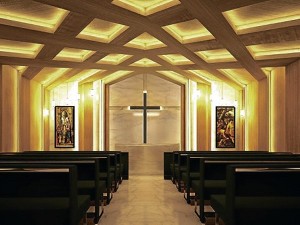Post-Lenten reflections on places of worship

THE CONCEPT design for a private chapel, a modern interpretation of the traditional vaulting system used in medieval churches. More and more developers are introducing ‘prayer’ and ‘meditation’ rooms into their facilities.
The past Holy Week was “celebrated” in many different ways. For some, the 5-day long weekend was a good time to wind down into a “staycation,” or a stay-at-home-vacation. Others took that short drive out to nearby churches for Visita Iglesia, and yet some went driving far out, hoping to catch sight of the Lenten penitents. I hope that for not so many, it was an opportunity to travel for a much-anticipated holiday with family or friends—fun and frolic with late nights of partying.
I remember the Holy Weeks of my youth to be quite different though. We experienced a number of Holy Weeks in my father’s farm in Bicol, and up north in La Union where my maternal grandparents were from. In both places, we immersed in the eerie quiet of Good Friday, broken only by the sound of the “pasyon” and the sights of processions, which set us pondering over the true meaning of Lent.
Today, Holy Week bears many meanings as believers continue to explore the different religions in their quest for a possibly more uplifting and even more meaningful spiritual practice. Indeed, times have changed, and even places of worship have evolved.
Transformation
The majority of Filipinos probably still adhere to the Roman Catholic upbringing and the traditions of its church, which in countless ways have been transformed. Mass is now conducted in malls and makeshift “churches” are set up in other venues in an attempt to make itself more accessible to its people.
Article continues after this advertisementBut other worshippers have deviated from tradition and found ways to connect with God in their own ways. The many spiritual practices—be it Buddhism, Hinduism, spiritualism, new age, and the many other variants—boil down to the universal need to connect with the Creator. Our high-speed lives in the age of the Internet have left little room for quiet introspection or the exercise of asking for guidance from the Higher Power.
Article continues after this advertisementAs a child, I remember many homes as having altars for their saints or “santos.” Today many still have them, but the dynamics of worship have changed. The modern-day equivalent of an altar is either a meditation room, a prayer room, or simply a “sacred space.” In homes, sacred spaces need not be rooms alone. A quiet corner, a small nook, or even a favorite armchair—thrown with the earnest intent of beseeching the goodness of God—can be a fitting venue for prayer.
I know of someone who sits for 30 minutes alone in meditation, on a sole armchair that rests smack in the middle of a circular, book-lined library. Another friend has a room where he sits for 10 minutes each morning on a huge pillow set on a “banig,” an everyday practice, except for Sundays when he attends church service. Another friend hies off to his beach house if even for a day, just to allow the powerful forces of nature to connect him to a higher consciousness in what could be a prayerful experience. God wasn’t joking when he said he was everywhere.
Connectedness
Corporate entities have also recognized the need for this connectedness. We are currently designing an office building that has a prayer room for the tenants, and another exclusively for the building owner and his company which will be occupying majority of the floors. For both, they have been termed as “prayer rooms,” meant for any religion.
At a residential condominium, we also designed a “meditation room”: a prayer room with an Eastern vibe—natural light filtering through window slats, floor pillows for meditation, chairs for the elderly. No kneelers: show your reverence instead with the force of your humble intentions. At another condo, we’re designing a space with all the Roman Catholic necessities to appropriately function as a true chapel: a crucifix, pews, images of the saints and a tabernacle.
On the flip side, we have on our drawing boards a school that promotes discipleship, and in some way, measures the success of its mission by the meaningful human relationships it creates. In this school, reverence and devotion is made through generating beautiful music together. Thus, this worship place will have large halls that are acoustically treated and equipped with some very complex lighting and audio systems, just a notch or two from being a real concert hall.
And many years back, we created a very high-quality yet visually spartan meditation center, with its sound system matching that of Carnegie Hall’s, and meant to give out the finest sound quality for a congregation that sat listening in silence as their Guru spoke.
While the Lenten traditions foster the spirit of prayer within worship places, prayer is a world that can go beyond established traditions. Fortunately, Lent reminds us to always reestablish that divine connection—regardless of where we are. I am truly grateful for a Lenten “staycation” that allowed me just that.
Contact the author through [email protected] or through our Asuncion Berenguer Facebook account.